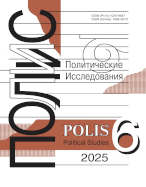Border interaction between Russia and European Union:
trends and modeling
Simonyan R.Kh.,
Dr. Sci. (Soc.), chief researcher, Institute of Sociology, RAS
Kochegarova T.M.,
Researcher, group «Russian-Baltic Centre», Institute of Sociology, RAS, sim@isras.ru
DOI: 10.17976/jpps/2014.05.04
Simonyan R.Kh., Kochegarova T.M. Border interaction between Russia and European Union: trends and modeling. – Polis. Political Studies. 2014. No. 5. https://doi.org/10.17976/jpps/2014.05.04
For many centuries Europe has been setting the tone in the world political and economic system. However, nowadays the question is about European role in the global world, rather than about its leadership. Moreover, the concern for preservation of the very European civilization is widely spread in the European intellectual establishment. The task of preserving Europe as a socio-cultural phenomenon will become increasingly important during the next decades. Without a geo-strategic cooperation with Russia it faces the risk of turning into a very small and diminishing part of the world population on a small and insignificant peninsula at the top end of a huge Eurasian continent. Europe is essential for modernization of Russia, which lost a lot of blood during reforms of the 1990s. In the emerging configuration of the world-system with its growing risks, the “good neighborhood” factor becomes decisive for providing public stability, as well as for socio-economic development of neighborhood states. Integration of the EU and Russian Federation is a geopolitical imperative, originating in strictly pragmatic interests of both sides, rather than some ideal motives. In effect, EU and Russia are facing the same global challenges, answers to which depend largely on combining their available resources. For Russia, EU is not only the main economic partner, concentrating more than a half of the global trade, but also a part of the Christian civilization. The common border of EU and Russia is situated in the Baltic region. Countries in this border area, which for a long time existed as a unite state, undergo a process of socio-cultural interaction of EU and Russia. Various models of institutional interaction, as well as of spontaneous socio-cultural diffusion are studied in the article.
See also:
Kulikov V.I.,
The world public forum «Dialogue of civilizations». – Polis. Political Studies. 2012. No5
Habermas J.,
Religion, law and politics. – On political justice in a multicultural World-Society. – Polis. Political Studies. 2010. No2
Lavrenov S.Ya., Slizovsky D.E.,
Central zone of traditional values of society. – Polis. Political Studies. 2013. No1
Chugrov S.V.,
Russia and Europe: Dialogue on Values in the Space of Civilization. – Polis. Political Studies. 2015. No4
Yakunin V.I.,
Dialogue of civilizations for the building of peaceful and inclusive societies. – Polis. Political Studies. 2012. No5




.jpg)






 print
print
.jpg)
.jpg)